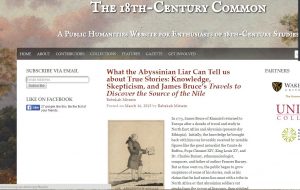In 2015 I wrote a Features post for The 18th-Century Common because I will never pass up an opportunity to tell the world about James Bruce, the verbose Scottish explorer who traveled to Abyssinia in the 1760s in search of the source of the Nile. But beyond the instant satisfaction of sharing something I find fascinating, contributing to a public humanities website turned out to be worthwhile for other reasons:
It was an opportunity to practice translating my research. In Fall 2015 I was on the job market, faced with the tasks of describing what I study to people outside my field, articulating how I make it interesting and relevant in undergraduate classes, and advocating for its intellectual and social impact. Reworking even a small piece of my project for a public audience helped me start developing language and examples to communicate its exigency.
It was a quick and open-access way for people to see what I do. I sent the link to people outside the academy who have been resources for me, and to friends and family who wanted to know more about what I study. It came up when search committees looked me up online. Students in the department that I will be joining in the fall read it, and they asked me questions about it during my campus visit.
It had a fast reach. I recently ran across a web exhibit about the European exploration of the Blue Nile that was put together by a History class at Washington and Lee University. I was pleased to see my post among their sources and amazed at how quickly it had an impact.
It turned out to be both fun and useful. And how often does that happen?
Editor’s note: Learn how you can get involved in public humanities project that is The 18th-Century Common.
Join Us
There are several ways you can get involved in the public humanities project that is The 18th-Century Common. How can I write for The 18th-Century Common? Respond to our latest Call for Papers Become a Collection Curator. Collection Curators draw on their […]


